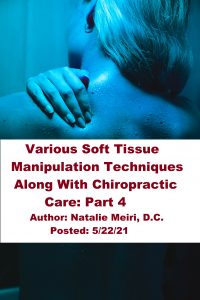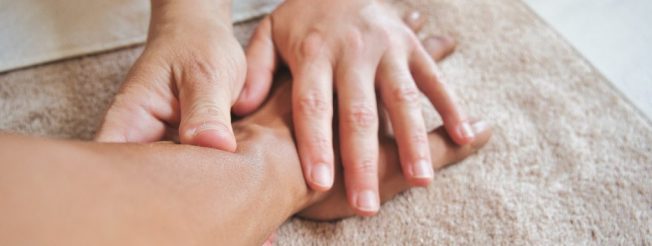
This is a follow up to the post Various Soft Tissue Manipulation Along With Chiropractic Care: part 3. As a review, Soft Tissue Manipulation (STM) techniques are defined as those physical methods applied to muscles, ligaments, tendons, fascia, and other connective tissues with the goal of therapeutically affecting the body. This post is about ischemic compression which is also a form of soft tissue manipulation technique. Read below about the Various Soft Tissue Manipulation Along With Chiropractic Care: part 4 on ischemic compression practiced in our West Palm Beach office.
What is Ischemic Compression?
Ischemic compression is a procedure. All the following named techniques use it to some degree: Receptor-tonus (Nimmo), Trigger point therapy (Travell and Simons), Active release technique, ART (Leahy), and acupressure. The difference is in the individual therapeutic approach and/or mechanism of treatment. Each of the named procedures above have varying explanations and theories, but the application is similar for Ischemic compression. The clinical application is basically deep manual pressure applied over tender muscular nodules.

Theories on the Mechanism of Ischemic Compression
Several theories have been suggested to explain the mechanism of ischemic compression. Travell and Simons believe that by holding pressure over a specific site, ischemia (inadequate blood supply) is induced to the sensory nerves. Subsequently, this produces a nerve block from lack of oxygen.
Another explanation is that after the release of manual pressure, a reflex vasodilation (widening of blood vessels which enhances blood flow) and hyperemia (excess of blood in the vessels) occur. This produces a circulatory increase capable of removing chemical irritants and metabolites. And also this brings in oxygen and adenosine triphosphates (ATP is the source of energy for use and storage at the cellular level) to the area for healing.
Finally, the last theory considers the mechanism that deep pressure produces pain that hyperstimulates interneurons (nerve cells that connect other nerve cells). This happens in the dorsal horn (part of spinal cord) to release endorphins that block pain perception.
The effects of ischemic compression are probably the result of a combination of mechanisms.
Various Soft Tissue Manipulation Techniques Along With Chiropractic Care: Part 4 – Receptor-Tonus Technique (Nimmo)
Dr. Raymond Nimmo was one of the first chiropractors to focus on the soft tissue component of dysfunction and subluxation (chiropractic joint misalignment or intersegmental joint dysfunction), advocating specific soft tissue treatment since 1950. Nimmo called the procedure for treating trigger points the receptor-tonus technique to emphasize his theory that it is a reflex technique and not a form of massage therapy.
Moreover, he suspected a neurologic explanation of treatment results because patients reported instantaneous pain relief after a treatment. He reasoned that only the nervous system was capable of creating changes in muscle tone within a few seconds. Receptor-tonus technique is therefore presented as a reflex technique that is thought to reduce muscle tonus (constant low level of activity in muscle) through reflexes mediated by the central nervous system. The presence of these body wall reflex points are explained by a reflex pain mechanism (see previous post on body wall reflex techniques).
Various Soft Tissue Manipulation Techniques Along With Chiropractic Care: Part 4 –
Trigger Point Therapy (Travell and Simons)
Dr. Janet Travell, M.D., placed a significant emphasis on the role of the myofascia in health and disease. Additionally, she was the first to use the term trigger point to describe the tender nodules in the soft tissues. Travell and Simons define a trigger point as “a hyperirritable spot, usually located in a taut band of skeletal muscle, that is painful on compression and can give rise to characteristic referred pain, tenderness, and autonomic phenomena”.
Both Travell and Nimmo techniques have evaluations which consists of postural assessment to identify gross (visible to naked eye) muscle imbalances and specific palpation of the myofascia (fibrous connective tissue) and related muscular involvement.
Myofascial trigger points (TrPs) are extremely common and affect nearly everyone’s life at one time or another. At a pain management center, a primary diagnosis of myofascial syndrome was assigned in 85% of cases among 283 patients. A neurosurgeon and a physiatrist made this diagnosis independently, based upon physical examination “as described by Simons and Travell.”
Soft tissue manipulation techniques along with chiropractic adjustments has many benefits for your health! Call 561-253-8984 and make an appointment today. And find out more about Various Soft Tissue Manipulation Techniques Along With Chiropractic Care: Part 4 at our West Palm Beach office at your first appointment!
The next post will be on mobilization and manual traction/distraction techniques (i.e. cranial manipulation, manual Lumbar Flexion-Distraction, Cox Method).
References:
Bergman, Thomas. Peterson, Lawrence. Chiropractic Technique Principles and Procedures 2011. Third Edition
Hammer, Warren. Functional Soft Tissue Examination and Treatment by Manual Methods.
Third Edition
Simons, David. Travell, Janet. Travell & Simons’ Myofascial Pain and Dysfunction: The Trigger Point Manual. 2nd edition
Meiri Chiropractic
561-253-8984